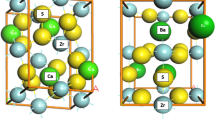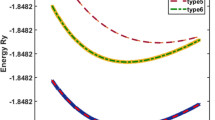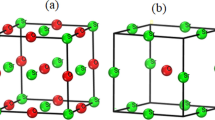Abstract
We have calculated the compressional, vibrational, and thermodynamic properties of Ni3S2 heazlewoodite and the high-pressure orthorhombic phase (with Cmcm symmetry) using the generalized gradient approximation to the density functional theory in conjunction with the quasi-harmonic approximation. The predicted Raman frequencies of heazlewoodite are in good agreement with room-temperature measurements. The calculated thermodynamic properties of heazlewoodite at room conditions agree very well with experiments, but at high temperatures (especially above 500 K) the heat capacity data from experiments are significantly larger than the quasi-harmonic results, indicating that heazlewoodite is anharmonic. On the other hand, the obtained vibrational density of states of the orthorhombic phase at 20 GPa reveals a group of low-frequency vibrational modes which are absent in heazlewoodite. These low-frequency modes contribute substantially to thermal expansivity, heat capacity, entropy, and Grüneisen parameter of the orthorhombic phase. The calculated phase boundary between heazlewoodite and the orthorhombic phase is consistent with high-pressure experiments; the predicted transition pressure is 17.9 GPa at 300 K with a negative Clapeyron slope of −8.5 MPa/K.









Similar content being viewed by others
References
Andersen A, Haflan B, Kofstad P, Lillerud PK (1987) High temperature corrosion of nickel and dilute nickel-based alloys in (SO2–O2)/SO3 Mixtures. Mater Sci Eng 87:45–50
Capillas C, Kroumova E, Aroyo MI, Perez-Mato JM, Stokes HT, Hatch DM (2003) SYMMODES: a software package for group-theoretical analysis of structural phase transitions. J Appl Cryst 36(3 Part 2):953–954
Carrier P, Wentzcovitch R, Tsuchiya J (2007) First-principles prediction of crystal structures at high temperatures using the quasiharmonic approximation. Phys Rev B 76(6):064, 116
Cheng Z, Abernathy H, Liu M (2007) Raman spectroscopy of nickel sulfide Ni3S2. J Phys Chem C 111:17997–18000
Fjellvåg H, Andersen A (1994) Properties of Ni3S2 at high temperatures. Acta Chem Scand 48:290–293
Fleet ME (1977) The crystal structure of heazlewoodite, and metallic bonds in sulfide minerals. Am Mineral 62:341–345
Giannozzi P, Baroni S, Bonini N, Calandra M, Car R, Cavazzoni C, Ceresoli D, Chiarotti GL, Cococcioni M, Dabo I, Dal Corso A, de Gironcoli S, Fabris S, Fratesi G, Gebauer R, Gerstmann U, Gougoussis C, Kokalj A, Lazzeri M, Martin-Samos L, Marzari N, Mauri F, Mazzarello R, Paolini S, Pasquarello A, Paulatto L, Sbraccia C, Scandolo S, Sclauzero G, Seitsonen AP, Smogunov A, Umari P, Wentzcovitch RM (2009) QUANTUM ESPRESSO: a modular and open-source software project for quantum simulations of materials. J Phys Condens Matter 21:5502. doi:10.1088/0953-8984/21/39/395502
Gibbs GV, Downs RT, Prewitt CT, Rosso KM, Ross NL, Cox DF (2005) Electron density distributions calculated for the nickel sulfides millerite, vaesite, and heazlewoodite and nickel metal: a case for the importance of Ni-Ni bond paths for electron transport. J Phys Chem B 109:21788–21795
Guo J, Griffin WL, O’Reilly SY (1999) Geochemistry and origin of sulphide minerals in mantle xenoliths: Qilin, southeastern China. J Petrol 40(7):1125–1149
Lin RY, Hu DC, Chang YA (1978)Thermodynamics and phase relationships of transition metal-sulfur systems: II. Nickel-sulfur system. Metall Trans B 9(4):531–538
Louie SG, Froyen S, Cohen ML (1982) Nonlinear ionic pseudopotentials in spin-density-functional calculations. Phys Rev B 26:1738–1742
Lu ZW, Klein BM, Singh DJ (1996) Electronic structure of heazlewoodite Ni3S2. Phys Rev B 54(19):13542–13545
Methfessel M, Paxton AT (1989) High-precision sampling for brillouin-zone integration in metals. Phys Rev B 40(6):3616–3621. doi:10.1103/PhysRevB.40.3616
Monkhorst HJ, Pack JD (1976) Special points for Brillouin-zone integrations. Phys Rev B 13:5188–5192
Murnaghan FD (1937) Finite deformations of an elastic solid. Am J Math 59:235–260
Parise JB (1980) Structure of hazelwoodite (Ni3S2). Acta Cryst B 36:1179–1180
Pasquariello DM, Kershaw R, Passaretti JD, Dwight K, Wold A (1984) Low-temperature synthesis and properties of cobalt sulfide (Co9S8), nickel sulfide (Ni3S2), and iron sulfide (Fe7S8). Inorg Chem 23(7):872–874
Perdew JP, Wang Y (1992) Pair-distribution function and its coupling-constant average for the spin-polarized electron gas. Phys Rev B 46:12947–12954. doi:10.1103/PhysRevB.46.12947
Perdew JP, Burke K, Ernzerhof M (1996) Generalized gradient approximation made simple. Phys Rev Lett 77:3865–3868
Prewitt CT, Gramsch SA, Fei Y (2002) High-pressure crystal chemistry of nickel sulphides. J Phys Condens Matter 14:11411–11415. doi:10.1088/0953-8984/14/44/491
Stølen S, Grønvold F, Westrum EF, Kolonin GR (1991) Heat capacity and thermodynamic properties of synthetic heazlewoodite, Ni3S2, and of the high-temperature phase Ni3 ± x S2. J Chem Thermodyn 23:77–93
Troullier N, Martins JL (1991) Efficient pseudopotentials for plane-wave calculations. Phys Rev B 43:1993
Vanderbilt D (1990) Soft self-consistent pseudopotentials in a generalized eigenvalue formalism. Phys Rev B 41:7892–7895. doi:10.1103/PhysRevB.41.7892
Wang JH, Cheng Z, Brédas JL, Liu M (2007) Electronic and vibrational properties of nickel sulfides from first principles. J Chem Phys 127(21):214, 705. doi:10.1063/1.2801985
Wentzcovitch RM, Yu YG, Wu Z (2010) Thermodynamic properties and phase relations in mantle minerals investigated by first principles quasiharmonic theory. In: Wentzcovitch RM, Stixrude L (eds) Theoretical and computational methods in mineral physics: geophysical applications. Reviews in Mineralogy and Geochemistry, vol 71, pp 59–98
Yu YG, Ross NL (2010) Prediction of high-pressure polymorphism in NiS2 at megabar pressures. J Phys Condens Matter 22:235, 401
Acknowledgments
Research supported by NSF grant EAR-0609885 to N. L. Ross, G. V. Gibbs and R. J. Angel. Computations are performed on the Hess cluster at the Geoscicence Department at Virginia Tech. YGY appreciates Prof. S. King and Prof. Y. Zhou for kindly sharing their computational resources and thanks R. Godbee for technical support.
Author information
Authors and Affiliations
Corresponding author
Rights and permissions
About this article
Cite this article
Yu, Y.G., Ross, N.L. Vibrational and thermodynamic properties of Ni3S2 polymorphs from first-principles calculations. Phys Chem Minerals 38, 241–249 (2011). https://doi.org/10.1007/s00269-010-0399-7
Received:
Accepted:
Published:
Issue Date:
DOI: https://doi.org/10.1007/s00269-010-0399-7




